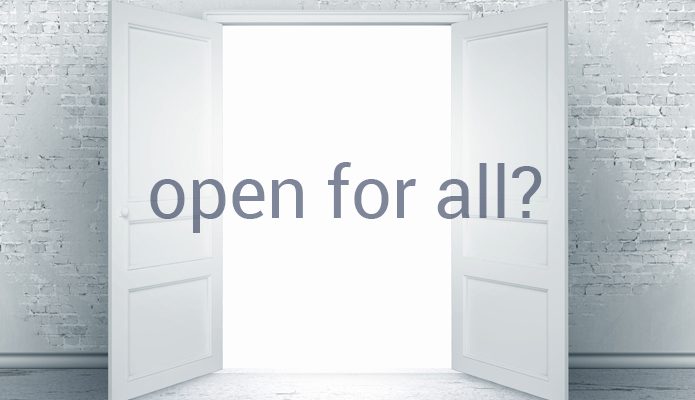The thinking of Comrade F. Dobler from the early 20th century remains relevant and even prescient: those who need open access to information may be those who are fundamentally excluded from public libraries.

Open to all?
The title for this column was taken from a piece of ground breaking research which I took part in as Head of Libraries in Merton (London, UK) in 2000. Open to all? The public library and social exclusion was the first study to consider how public libraries could tackle social exclusion and bring library services to the poor, the disadvantaged and the oppressed.
We found that those who needed libraries the most (those with the greatest needs) often used them the least; and conversely we discovered that those who needed libraries the least (those with the least needs) used them the most. So things were completely the wrong way around and we located the reason for this in the history of public libraries which were originally established as state institutions of social control whose intended audience was what the Victorians called ‘the deserving poor’. This discourse continues today and has shaped professional attitudes and mindsets.
And so, if we are going to shift this dominant paradigm, we also need to shift these professional values; which means that we need a completely different kind of library workforce. As Tom Peters once famously observed, ‘If you cannot change the people, then you have to change the people.’ But how do you achieve this challenging task?
Suggestions for transformational change in Workforce Development were embedded across all of the Open to All? recommendations (from Needs Assessment and Research to Outreach, Community Development and Partnerships), but there were also some specific ways forward identified:
1. Public libraries need to reassess their recruitment and selection policies (including reassessing the requirement for qualifications in librarianship) in order to attract more staff into the workforce from socially excluded backgrounds.
2. Public libraries should urgently analyse the training needs of their staff, to ensure that they have the necessary knowledge and skills to provide the best services for socially excluded people. Training programmes to be developed for all services linking equal opportunities, anti-racism, anti-sexism, cultural and social exclusion awareness.
3. Public libraries should adopt positive action programmes so that the library workforce incorporates socially excluded people more equitably than at present. All library authorities should aim to develop recruitment and selection statements outlining how this will be achieved.
4. Public libraries should challenge staff and organisational attitudes, behaviour, values and culture through staff development and training and a competency-based approach to staff recruitment and appraisal.
5. Library authorities should change their staffing structures to bring them in line with their social exclusion strategies. This will require new job titles, job descriptions, person profiles and competencies which recognize the importance of outreach and should lead on service delivery to the socially excluded.
6. Schools of Information and Library Studies (SILS) should review their recruitment base to ensure that people from ‘non-traditional’ backgrounds are brought into library work.
7. SILS need to urgently reassess their course content in conjunction with public libraries. Courses should incorporate core modules which cover social exclusion issues, such as the causes of social exclusion, information poverty and equal opportunities.
I think that these recommendations have stood the test of time and are as relevant today as when they were written 16 years ago. I like the way that #2 broadens out the training base to encompass issues such as anti-racism and anti-sexism. This is important in communities like mine where racism is a big issue. I also like #3 because I have seen how positive recruitment can have a big impact on staff attitudes and behavior.
When I was Head of Libraries in Lincolnshire (UK) we positively recruited from our migrant worker communities. We then had migrant workers on staff who understood the needs of this much maligned community, and who could educate fellow workers and the communities they worked with. Staff and library patrons could no longer use the language of ‘the other’ when they worked alongside migrants who could explain that their needs – for well paid employment and decent housing and education for their families – was no different to that of the host community. #5 is also important because structures should always be aligned with strategies and systems.
The ultimate test of Open to All? is, did its recommendations actually make a difference?
Unfortunately this proof has been provided through the experience of those public libraries which were either unwilling or unable to change. This has led to hundreds of library closures and thousands of library worker layoffs in the UK. The Traditional Public Library (transactional model) has been swept away by the winds of neoliberal ideology, masked behind an austerity agenda.
Public Libraries which embraced the Open to All? recommendations and began the task of developing a Needs Based Library are those which have best weathered the storm. It is important to point out that the Open to All? recommendations were stepping stones on the never ending journey towards the development of a Needs Based library, which is the ultimate extension of what we in Canada call a Community Led library. This term is used in a very different context in the UK where ‘community led’ means replacing paid library workers with unpaid community volunteers. This in turn is part of a so-called ‘Big Society’ narrative which sees public services being taken over by the private and voluntary sectors.
The best antidote to this political poison is the adoption of robust strategies, structures, systems and an organizational culture which is focused on those with the greatest needs.
John Pateman is the CEO / Chief Librarian of the Thunder Bay Public Library. The Open for All? column explores the nature of libraries and their commitment to openness.
